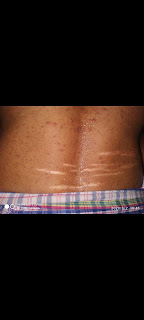35 F with nephrotic syndrome
35 year old female P2L2A1 presented to casualty with complaints of :
Pedal edema since 6 months
Sob since 6 months- grade 1 initially progressed to grade 4 .
Loss of appetite since 6 months
Fatigue since 6 months
Generalized anasarca since 3 months .
Timeline of events :
On presentation her vitals :
Bp -160/100 mmhg
Pulse rate - 108 bpm,regular normal volume ,no radio radial delay .
RR - 28/min.
Spo2- 88% On RA and with 6 lit oxygen 94%
Grbs -125 mg/dl
Temp -99.4 F
GENERAL EXAMINATION :
Pt C/C/C
Pallor - present
No icterus , clubbing, cyanosis,koilonychia , lymphadenopathy .
B/L pedal edema - pitting type present.
Generalized anasarca noted
Jvp - elevated
Skin - Dry ,scaly , itching present .
Hyperpigmented skin lesions noted on hands ,over chest wall and over knee and shin of both legs .
SYSTEMIC EXAMINATION :
Cvs - S1S2 present
RS - B/L diffuse crepitations heard in all areas .
CNS - No FND .
INVESTIGATIONS:
CUE was showing 3 + albuminuria with no RBC.
24 hr urine protein was 1.3 g
Spot protein creatinine ratio is 4.83.
Hiv ,hbsag and HCV - negative
ESR - 35 mm/hr
PT - 27 sec ; INR - 2 ; aptt - 42 sec
Lipid profile :
TC - 164
HDL - 35
LDL- 105
VLDL - 24
TG -122
THYROID PROFILE :
T3- 0.11 ; T4- 11.8 ; TSH - 6.88
USG ABDOMEN :
B/L gross pleural effusion
B/L grade 2 RPD changes with
Right kidney measuring - 10 x 4.2 cm
Left kidney measuring - 9.8 x 4.1 cm
2D echo :
Global hypokinesia
Severe Lv dysfunction (EF-33 %)
Grade 3 diastolic dysfunction
Mild MR and PAH.
With above history and examination and investigations provisional diagnosis was
HFREF
Nephrotic syndrome under evaluation .
? Cardio renal syndrome - Type 5
K/C/o HTN .
Intially
In view of fluid overload /Refractory pulmonary edema patient underwent Hemodialysis.
5 sessions of hemodialysis was done .
Patient developed LEFT lower limb DVT at the site of femoral catheterization for hemodialysis.
She was started on LMWH for 5 days followed by apixaban 2.5 mg Bd .
After intial stabilization patient was being evaluated for nephrotic syndrome, so a renal biopsy was performed.
Renal biopsy was suggestive of Renal amyloidosis .
Once the diagnosis of renal amyloidosis was established. Next was to rule out whether it's primary or secondary amyloidosis.
Amyloidosis is a heterogeneous disease that results from the deposition of toxic insoluble beta-sheet fibrillar protein aggregates in different tissues. Amyloidosis can be acquired or hereditary. The disease can be localized or systemic. Amyloid can accumulate in the liver, spleen, kidney, heart, nerves, and blood vessels, causing different clinical syndromes, including cardiomyopathy, hepatomegaly, proteinuria, macroglossia, autonomic dysfunction, ecchymoses, neuropathy, renal failure, hypertension, and corneal and vitreous abnormalities.
Previously multiple classification systems have been devised to classify different types of amyloidosis. In modern times it has been classified according to the chemical analysis of amyloid clinical entities. Amyloidosis can be classified according to systemic, hereditary, central nervous system, ocular, and localized etiology. However, the most common types are AL, AA, ATTR (amyloid transport protein transthyretin), and dialysis-related amyloidosis (beta2M type).
In AL amyloidosis, 'A' represents amyloid followed by the associated fibrillar protein, 'L' means light chain fragment or immunoglobulin light chain. In AA amyloidosis, the second A stands for the serum amyloid A protein.
https://www.ncbi.nlm.nih.gov/books/NBK470285/
Investigations done to detect evidence of monoclonal plasma cell disorder :
1) SIEP ( Serum immuno-electrophoresis ) - Negative for monoclonal protein.
2) SFLC - ( Serum free light chain ) = 2.66
Serum Kappa light chain - 441
Serum lambda light chain - 165.5
3) ESR - 35 mm
4) Bone marrow aspiration - Reactive marrow with plasmacytosis . Mild increase -12 to 15 % plasma cells .
Other investigations :
C3/C4 - 93/77
ANA /ANCA/DS DNA = negative
Anti CCP = negative
Anti cardiolipin and beta 2 glycoprotein = negative.
CAUSES FOR SECONDARY AMYLOIDOSIS:
Patient gives no history of joint pains ,rashes ,oral ulcers ,hair loss .
Investigations for secondary amyloidosis:
1) HRCT chest :
Right moderate pleural effusion
With collapse of middle lobe with left mild pleural effusion .
Atelectatic bands in right middle lobe
Cardiomegaly with LA ,LV enlargement.
2) Mantoux test - 20 mm
3) Bronchoscopy - Normal and BAL was sent for AFB which was negative by auramine rhodamine stain
Koh mount - no fungal elements
Cell count : DLC - Neutrophils - 100%
Lymphocytes - 0 %
4) PET CT was performed :
Shows metabolically active mediastinal nodes
B/L pleural effusion
FDG avid enlarged prevascular , right upper , lower paratracheal and subcarinal nodes noted.
- Probably granulomatous .
In view of granulomatous lesions on PET CT a diagnosis of
? Secondary amyloidosis (AA amyloidosis) was made secondary to Pulmonary kochs and patient was started on ATT.
On follow up her investigations : in September
Hb - 10.2 h/dl
TLC - 7000 cells /mm3
Platelets - 2.5 lakhs
S. Creat - 2.8 mg/dl
Urea -77 mg/dl
2D echo :
Suggestive of Severe Lv dysfunction and Diastolic dysfunction +
Global Lv Hypokinesia.
? DD secondary to restrictive cardiomyopathy due to amyloid deposition .
2D echo links :
https://youtube.com/shorts/qy6EGkRAYjs?feature=share
https://youtube.com/shorts/DC9-pqFw0oc?feature=share

.png)













Comments
Post a Comment